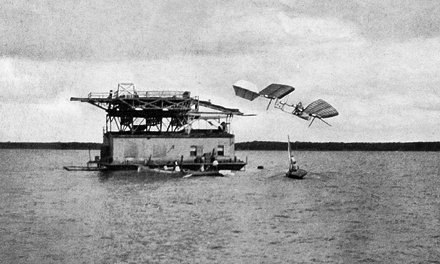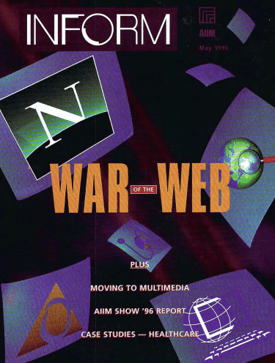
3 Lessons from the Wright Brothers about Content Management
Enterprise Content Management (ECM) | Intelligent Information Management (IIM)
I recently read David McCullough’s The Wright Brothers. Before delving into my curious connection between the Wright Brothers and content management, let me put my reviewer hat on – it’s a very good book. I’ve always had an interest in the Wright Brothers for many reasons, but especially because their breakthrough occurred on the Outer Banks of North Carolina, one of my favorite places in the world. Also, true confessions, I was a history major.

The Wright Brothers does a great job of filling in so many gaps in the personal story of the Wrights and does so in McCullough’s usual personal, well-researched, and thoughtful style. But in addition to all of that, I especially liked the lessons the book presents about the nature of innovation, particularly as I think about the dramatic changes going on in the enterprise IT arena and within content management.
Lesson #1 – Beware Conventional Wisdom.
In the early 1900s, the conventional wisdom was that the long-anticipated breakthrough in manned and powered flight would come from Samuel Pierpont Langley.
Per Wikipedia, Samuel Langley was an American astronomer, physicist, inventor of the bolometer, pioneer of aviation, and became the third Secretary of the Smithsonian Institution in 1897. Langley’s design had wire-braced tandem wings (one behind the other). It had a Pénaud tail for pitch and yaw control but no roll control, depending instead on the dihedral angle of the wings for maintaining roughly level flight. His approach also had no landing gear, and was designed to be launched from a catapult on top of a boat in the Potomac River and then crash land into the Potomac. Wikipedia notes, “Langley gave up the project after two crashes on take-off on October 7 and December 8, 1903. In the first attempt, Langley said the wing clipped part of the catapult, leading to a plunge into the river ‘like a handful of mortar,’ according to one reporter. On the second attempt, the craft broke up as it left the catapult.”

Ultimately, the federal government invested about $70,000 in Langley’s unsuccessful venture. The Wright Brothers spent a total of about $1,000 (including transportation back and forth from Dayton to the Outer Banks) on their venture.
The “smart” money was on Langley. The “conventional” wisdom embraced Langley. And it was all dead wrong.
Conventional wisdom in the content management space says,
“Look at what worked in the past.”
“Beware of new vendors.”
“Respond to new governance challenges by doubling down on the control side of the equation.”
“Continue to view content management through the prism of IT rather than that of knowledge workers.”
Lesson #2 – Understanding the Process is More Important than the Technology.
McCullough talks in great detail about the steps the Wright Brothers took before they even ventured down the path of attaching an engine to their design. They started in Kitty Hawk in 1900 – it wasn’t until 1903 that the engine even entered into the equation of figuring out the mystery of powered flight.
They were obsessed with understanding the nature of how a person interacted with the process of flying. Per Wikipedia, “From the beginning of their aeronautical work, the Wright brothers focused on developing a reliable method of pilot control as the key to solving ‘the flying problem.’ This approach differed significantly from other experimenters of the time who put more emphasis on developing powerful engines.”
Many forget that the Wright Brothers ran a bicycle business. The importance of this is that a key lesson of this business (also at the time, a relatively new technology) was the interaction of a person with a machine. In other words, how does one actually ride a bicycle? A person does not just sit on a bicycle and wait for something to happen. You need to interact with the machine, use the machine itself for steering, and essentially become indistinguishable from the machine.
As the Wrights began their experiments in Kitty Hawk, they were preoccupied with this question of pilot control. In contrast to Langley’s approach – which utilized a much more powerful motor than the Wrights did – the Wrights were focused on the question of how one interacted with the technology to achieve the desired result.
Content Management has long been an arena in which “technology” has received the lion’s share of attention in the triad of people, process, and technology. When we look at ECM implementations that succeeded versus those that failed, a common element is that those that succeed ultimately understand that “ECM” is not about technology. It is about the interaction of people and process WITH technology. We recently met with a company that had been plugging through a gigantic, multimillion-dollar ECM project driven by their IT department. After many years, they had only achieved 2 of their initial 10 objectives, and no one was very excited about those. And there was a lot of software sitting on the shelf.
People. Process. Technology. The Wright Brothers understood that appropriate Technology needs to flow FROM a detailed understanding of People and Process, NOT THE OTHER WAY AROUND. And we need to understand that better in the Content Management space, especially in this era of consumer technology.
Lesson #3 – Radical Technologies Improve Dramatically and Quickly…But Their Application is Another Question
On 10:35 a.m. on December 17, in front of five witnesses, the Wright aircraft (Flyer I) ran down a monorail track, stayed aloft for 12 seconds and flew 120 feet. Three more flights were made that day, and Wilbur flew the last flight, covering 852 feet in 59 seconds (a 392% improvement!). By 1905, the Wright Flyer III could make somewhat complex maneuvers and stay aloft for 39 minutes (a nearly 20,000% improvement in performance), covering a distance greater than all of the previous 109 flights combined. In less than 2 years.
But no one cared, and no one believed. In part because of the Wrights’ concerns about lack of a patent, publicity about the pending revolution was scant. The only significant coverage was in a beekeeping journal. Scientific American declined to cover the “alleged experiments” by the Wright Brothers. Despite the incredible progress from 1903-1905, the Wrights made no additional flights in 1906-1907, largely due to their insistence that they possess a firm contract before conducting a demonstration. The U.S. military, likely because they had invested $50,000 in the failed Langley aircraft, declined interest in the aircraft. The Paris edition of the New York Herald noted, “The Wrights have flown, or they have not flown. They possess a machine or they do not possess one. They are in fact either fliers or liars. It is difficult to fly. It's easy to say, 'We have flown.'”
On August 8, 1908, Wilbur Wright made a short demonstration flight at Le Mans, France, and the Wrights became a worldwide sensation almost overnight. And we all know the rest of the story.
Over the last 20 years, we have seen dramatic changes in Content Management. When I first took the job at AIIM in 1996, the same magazine announcing my appointment noted, “until the webmeisters persuade us otherwise, we'll hang onto our CDs and floppies, along with the aperture cards and other imaging artifacts that have served our corporate and personal purposes so cost-effectively in the past.” Yikes.

Less than 10 years ago, I can remember meetings with leading ECM vendors who dismissed SharePoint as “not real” ECM and not really a competitive threat. Almost overnight, MOSS drove a massive and fundamental pivot in the ECM space from a technology and an industry-driven and dominated by the needs of relatively few document specialists to one that would be defined by a broad base of knowledge workers. This pivot would carry with it a collapse in traditional (i.e., high) per seats price points and a reshuffling of the fundamental economic assumptions governing the ECM space.
And less than 3 years ago, I can recall Board discussions in which Box and other file sync and share solutions were described as “not serious” ECM.
The point? Like the Wright Brothers, radical innovators are often initially dismissed. THEY see the possibility of a transformed future, but no one else does. THEY work in relative obscurity until seemingly they are "instantly" famous and ubiquitous. We forget the transition period that was a necessary precursor to the seemingly “instant” revolution.
Mary Meeker from Kleiner Perkins Caufield Byers does an AWESOME annual assessment of Internet Trends. The 2015 version was released last week.
On slides 29-45, she talks about what I see as the next revolution in Content Management, although she doesn’t mention “Content Management” or “ECM” by name (another problem for another day!) -- content-intensive enterprise applications created from the ground up on a cloud and mobile base. Applications that are consumed, purchased, implemented and utilized by companies and organizations in a fundamentally different way from the way we viewed enterprise applications as recently as five years ago. Here’s a sample.
|
Business communications |
|
|
Offline payments |
|
|
Online payments |
|
|
Business analytics |
|
|
Signatures |
|
|
Custom communications |
|
|
Customer success |
|
|
Customer service |
|
|
HR benefits |
|
|
Enterprise planning |
|
|
Recruiting |
|
|
Background checks |
|
|
Employee training |
|
|
Visitor management |
All these enterprise applications have seemingly appeared overnight, but are actually the result of consumer innovations that have been brewing over the past few years, and only now are reaching the critical mass of a Wright Brothers "overnight" sensation.
We are in truly interesting times for Content Management. I remain convinced that our collective task is to focus on these two questions for knowledge workers. And probably in the reverse order from what I have them here:
Where do I put my “stuff” so that it is secure, shareable, and searchable so that my ORGANIZATION can accomplish its goals?
AND
Where do I put my “stuff” so that it works the way I work and is useful to ME in getting my job done?
About John Mancini
John Mancini is the President of Content Results, LLC and the Past President of AIIM. He is a well-known author, speaker, and advisor on information management, digital transformation and intelligent automation. John is a frequent keynote speaker and author of more than 30 eBooks on a variety of topics. He can be found on Twitter, LinkedIn and Facebook as jmancini77. Recent keynote topics include: The Stairway to Digital Transformation Navigating Disruptive Waters — 4 Things You Need to Know to Build Your Digital Transformation Strategy Getting Ahead of the Digital Transformation Curve Viewing Information Management Through a New Lens Digital Disruption: 6 Strategies to Avoid Being “Blockbustered” Specialties: Keynote speaker and writer on AI, RPA, intelligent Information Management, Intelligent Automation and Digital Transformation. Consensus-building with Boards to create strategic focus, action, and accountability. Extensive public speaking and public relations work Conversant and experienced in major technology issues and trends. Expert on inbound and content marketing, particularly in an association environment and on the Hubspot platform. John is a Phi Beta Kappa graduate of the College of William and Mary, and holds an M.A. in Public Policy from the Woodrow Wilson School at Princeton University.



